In terms of network cabling, ensuring strong and secure connections often hinges on the reliability and efficiency of an RJ45 plug. Many innovations in networking hardware have arisen over time, including passthrough RJ45 connectors. These connectors were developed to improve the overall performance of cables by simplifying the wiring processes, lowering error rates, and improving performance levels. But what exactly makes them different from conventional RJ45 plugs, and why are they so increasingly popular among professionals and hobbyists? This guide will focus on passthrough RJ45 connectors, covering everything from features, benefits, and practical applications. Veteran or novice in IT, this article shall provide the necessary information you will need to enhance your networking tasks, projects, or goals.
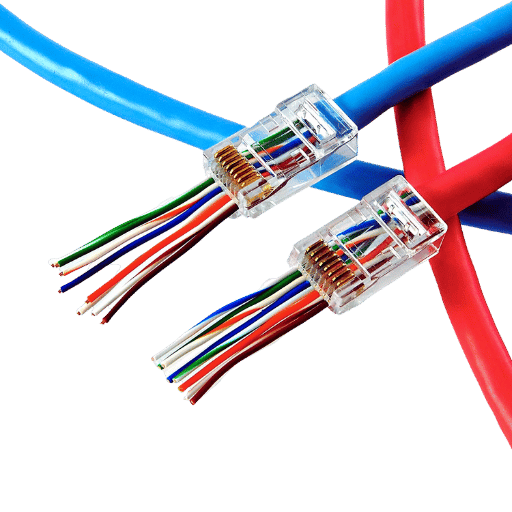
A pass-through RJ45 connector is an Ethernet connector that allows the wire conductors to pass through the plug before termination. This design simplifies aligning and inserting wires, resulting in greater accuracy regarding terminations. Pass-through connectors make it easier to reduce errors, improve signal performance, and accelerate all installations, making them a practical option for networking projects.
The RJ45 connector passthrough design has three distinctive features that benefit networking specialists and installations. It guarantees accurate alignment of wires, which minimizes the chances of wiring mistakes compromising the signal quality. Additionally, it enables quicker terminations by allowing more efficient passthrough terminations, thus saving time during installations. Moreover, enhanced connectivity reliability is achieved by better contact with the conductors, which leads to stable and excellent network performance. These benefits make passthrough RJ45 connectors more pragmatic for small and big networking jobs.
A pass-through connector allows the individual conductors of a cable to pass through the body of the connector and escape just in front of it. This permits easier verification of the proper wire alignment and position before crimping. After the wires are arranged suitably, the connector is crimped with a unique tool that cuts the unwanted conductors and fixes them permanently. The terminations are precise, the conductors are securely held, the signal contact electrically and physically is efficient, and there is almost no signal loss.
Pass-through RJ45 connectors have notable advantages, which include:
With all these advantages, pass-through RJ45 connectors are a reliable choice for professionals who want to achieve efficiency and precision in network cabling.
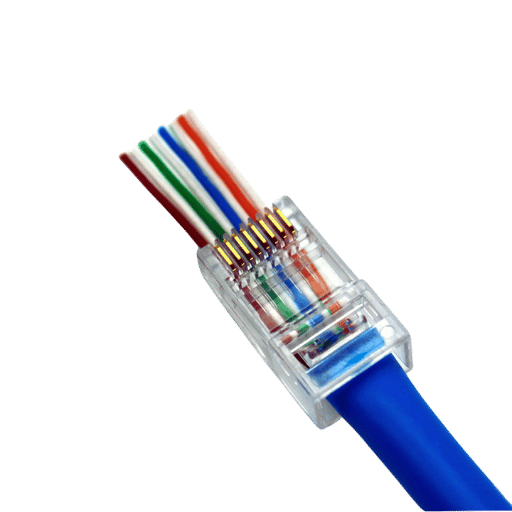
As with everything, pass-through and non-pass-through RJ45 connectors differ in design and usage. The pass-through connectors’ design allows the wires to pass through the connector, which makes aligning the wires and verifying the order much easier before crimping. This design encourages efficient installation with fewer errors. Thus, it can be used for a faster and more precise assembly. Non-pass-through connectors, in contrast, are more accurate but offer a less stylish finish. In this case, the wires must be trimmed before connecting, demanding more precision and effort. In most scenarios, people prefer pass-through connectors owing to their unmatched efficiency, especially in terms of time and reliability for professionals.
The main factor to consider when choosing between shielded and unshielded connectors is the environment where they will be used. Shielded connectors are emitted where there is a dense electrical noise, like in industrial environments, which are prone to EMI. On the other hand, unshielded connectors are cheap and work in low-interference environments like standard office and residential buildings. In essence, shielded connectors should be used in environments with EMI, and unshielded connectors should be utilized where simplicity and cost are the goal.
Cat6 and Cat5e cables will work effectively as long as the shielded or unshielded connectors fit the designed cable type and specification. For optimal performance, it is best to use connectors rated for the cable category, as this not only assures proper performance but also maintains the cable’s transmission standards. This compatibility guarantees effective data transmission in numerous scenarios, whether in residential networks or advanced commercial environments. Always check the ratings for the connectors to ensure they align with the appropriate cable.
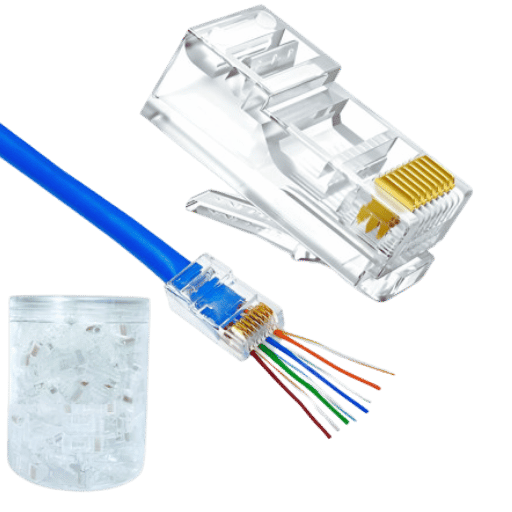
The decision on which crimp tool to use depends on the specific connector and cable. Check if the tool suits the connector’s shape and dimensions, such as RJ45 plugs for Ethernet, which require a particular tool. Consider a multi-purpose tool that can change settings for varying connectors for accurate crimps. Also, ergonomic handles and wire-cutting or stripping features should be considered for effective tool handling. Go for well-established brands that offer the best quality and performance. Ensure the tool meets the specific job requirements needed to be applied in the relevant industry.
One common mistake is improper wire stripping, in which excess insulation is left or the conductor is damaged. To prevent this, always use a wire stripping tool adjusted to the correct gauge.
Another frequent mistake is using wires with different gauges or erroneously applying wires that don’t qualify for specific tasks. Follow manufacturer guidelines and consult industry standards to avoid overheating and low conductivity.
Some faults caused by poorly secured screws or incompletely crimped connectors can lead to totally failing circuits. Check all wires and ensure you use the right approach to attain definite tightness in all connections.
Ensure wires are well organized and labeled to avoid confusion when troubleshooting issues down the line. Employing diagrams, labels, and color-coded wiring offers clarity for complex wiring systems, so use them.
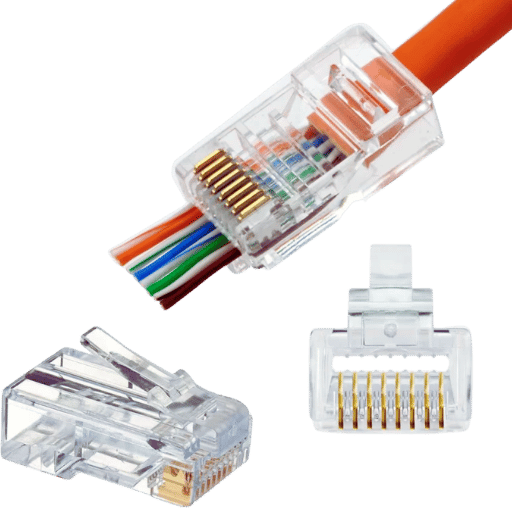
As with any technology, pass-through RJ45 connectors are beneficial for various reasons. Wires are more straightforward to terminate since they can move freely without the termination verification step. Hence, cutting is also easier. Because of this, errors are reduced, and dependable connections are ensured. Moreover, their relatively simple assembly process increases time efficiency.
Pass-through connectors also have disadvantages. Non-pass-through standard connectors are more cost-effective, making pass-through-based options rather pricey. In addition, some installers reported that trimmed excess wire can lead to short circuits or interfere with the desired signal if care is not taken. This problem requires care and the use of the correct tools and techniques.
Regarding performance analysis, pass-through RJ45 connectors stand out for their ease of installation and excellent accuracy in connector alignment. They allow for visual inspection of wire alignment before crimping, which minimizes wiring errors and guarantees accurate signal transmission. This may lead to improvement in network performance and lower troubleshooting time.
Signal quality and durability are comparable with traditional RJ45 connectors because they are less expensive. Still, wires need to be trimmed and aligned precisely to get these, increasing the chances of error during assembly. When installed correctly, however, they can still provide the same level of signal quality.
In the end, it is a question of which pass-through or traditional RJ45 connectors to choose that is dictated by project requirements in which cost, installation period, and skill of the installer must be weighed.
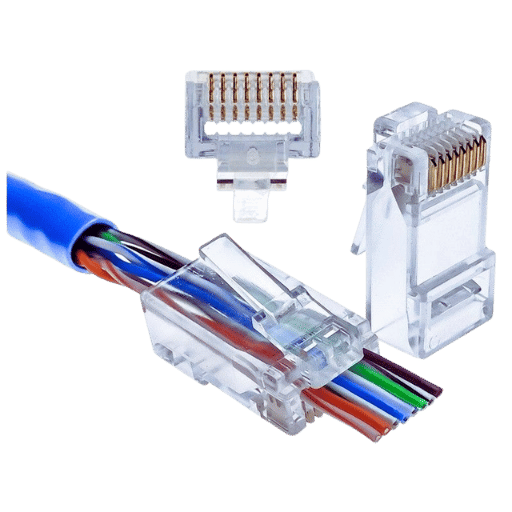
Every market segment has its share of RJ45 connectors, ranging from pass-through to non-pass-through versions, each addressing distinct needs. Espouse connectors come in ‘shielded’ and ‘unshielded’ varieties that cater to different environmental conditions. These connectors are also designed to protect against electromagnetic interference (EMI), which makes them ideal for industrial zones or regions of high interference. The construction of pass-through RJ45 connectors makes the installation task easier since the specialist can confirm wire alignment before crimping, reducing the chances of errors. Modular plug connectors also exist, allowing full for solid or stranded cables, ensuring the best performance. Choosing the right RJ45 connector depends on the cable type used, the deployment place, and the performance requirements.
In telecommunications and networking, modular plugs are essential components. These plugs are engineered to interface with twisted pair cables like CAT5e, CAT6, and CAT6a. Modular plugs are often used with stranded conductors, which are more frequently used for portable applications, unlike solid conductors, which are fitted at fixed locations. Modular plugs are commonly used in telephone lines and Ethernet connections, allowing for a seamless signal transmission. Their design is so precise that it can be used in commercial and residential networks without compromising performance. The plugs help to minimize interference, leading to better signal quality, and assist in the swift transmission of data.
Advanced RJ45 plugs – known for modern networking environments due to their greater performance, durability, and ease of installation – have recently received innovations that feature shielded designs for reduced electromagnetic interference (EMI), tool-less or quick connect terminations for faster deployment, and multi-cable type compatibility, including CAT5e, CAT6, and CAT6A. Specific variants of these plugs also feature gold-plated contacts for enhanced conductivity and corrosion resistance, thus providing dependably long-term connections. Due to such features, advanced RJ45 plugs are designed to withstand demanding commercial and industrial uses, supporting faster data transmission and better network reliability.
A: Multi-pin pass-through connectors are ethernet connectors that permit the wires to pass through the connector. This design allows for easier verification of the proper wire sequence before crimping and guarantees a strong connection. It is often used with ethernet cables such as Cat6 RJ45.
A: Pass-through connectors allow wires to extend through the connector, unlike non-pass-through RJ45 connectors. This feature eases installation and ensures correct conductor alignment, thus enhancing the connector’s reliability.
A: These connectors are considered easy to install as technicians can push the wires through the connector. This helps quickly validate the correct color order before crimping, which minimizes mistakes and productivity.
A: While pass-through RJ45 connectors can be adapted to different types, they are mainly used with Cat5e, Cat6, and even Cat7 Ethernet cables. Connectors should be chosen based on the cable’s specifications for better performance.
A: Such connectors are simple to use, provide a good connection, and allow for easy verification of the proper positioning of the wires. VCELINK pass-through RJ45 connectors are built for effectiveness, considering multiple favorable networking requirements.
A: Traditional crimping tools can usually be used on pass-through RJ45 connectors. However, a tool made specifically for pass-through connectors is preferable for enhanced results and ease of use.
A: Pass-through connectors have an enhanced strength rating because they provide a more accurate termination of the ethernet cable, decreasing the chances of conductor misalignment. Therefore, the connection is stiffer, durable, and reliable.
A: While any standard crimping tool can be used, a specially designed tool for pass-through RJ45 connectors is recommended. This would ensure that the connectors are crimped securely and uniformly, leading to better performance.
A: The color scheme in pass-through RJ45 connectors guarantees that the ethernet cables are terminated in the proper sequence. This is essential for ensuring data transfer and crosstalk integrity. It also helps maintain uniformity and prevents wiring mistakes.